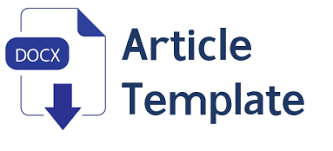Theory of Planned Behavior: Intention to Quit Smoking at Universitas Negeri Malang during Pandemic Covid-19
Downloads
Background: Smoking has become a lifestyle. Smokers are dominated by teenagers, including college students. Smoke from cigarettes clearly poses a danger to the body's health and the environment, especially during the COVID-19 pandemic. During the pandemic, college students spend more time at home which can increase smoking behavior too. Aims: The purpose of this study is to analyze the description of the intention to quit smoking at the State University of Malang during COVID-19 based on the Theory of Planned Behavior (TPB). Methods: This research is a type of quantitative analysis using primary data. The instrument used is a questionnaire which is filled out independently by the respondent. Data collection was done online for 100 students of the State University of Malang. The statistical test used in the analysis is the Chi-square test and Regression Logistic. Results: Variables related to the intention to quit smoking were attitude (sig=0.03 < α=0.05) and behavioral control (sig=0.00 < α=0.05), while the subjective norm variable had no relationship with intention, quit smoking (sig=0.077 > α=0.05). Behavioral control has a significant effect on the intention to stop smoking (sig = 0.00 > α=0.05). Conclusion: There is a relationship between attitude and behavioral control with students' intention to quit smoking. Only behavioral control affects the intention to quit smoking, so it is necessary to strengthen this variable to increase the intention of students at the State University of Malang to quit smoking and as an effort at tobacco control among adolescents.
Ajzen, I. (1991) ‘The Theory of Planned Behavior’, Organizational Behavior and Human Decision Processes, 50(2), pp. 179–211.
Alamsyah, A. and Nopianto (2017) ‘Determinan Perilaku Merokok pada Remaja’, Journal Endurance, 2(1), pp. 25–30.
Asare, M. (2015) ‘Using The Theory Of Planned Behavior TO DETERMINE’, American Journal of Health Studies, 30(1), pp. 43–50.
Atmojo, J. T., Soemanto, R. and Murti, B. (2017) ‘Determinants of Successful Smoking Cessation in Surakarta’, Journal of Health Promotion and Behavior, 02(04), pp. 332–344. doi: 10.26911/thejhpb.2017.02.04.05
Badan Pusat Statistik (2016) Presentase Remaja Jawa Timur yang Merokok Menurut Kabupaten/Kota dan Jumlah Rokok yang Dihisap Per Minggu dalam Satu Bulan Terakhir Tahun 2015, Badan Pusat Statistik. Available at: https://pasuruankota.bps.go.id/statictable/2016/08/03/ (Accessed: 15 March 2020).
Blankers, M. et al. (2016) ‘Modelling intentions to provide smoking cessation support among mental health professionals in the Netherlands’, Tobacco Induced Diseases, 14(1), p. 32. doi: https://doi.org/10.1186/s12971-016-0096-5
Dewi, E. U. (2020) ‘Pengaruh Kecemasan Saat Pembelajaran Daring Masa Pandemi COVID-19 Terhadap Prestasi Belajar Mahasiswa STIKES William Surabaya’, STIKes William Booth Surabaya.
Ferdiansyah, A. I. (2017) Perilaku Merokok Mahasiswi di Kota Malang (Smoking Behaviour on Female Students In Malang City). Universitas Brawijaya.
JDIH (2019) ‘Rancangan Peraturan Daerah Kota Surabaya tentang Kawasan Tanpa Rokok’, Naskah Akademik. Surabaya: JDIH Kota Surabaya. Available at: https://jdih.surabaya.go.id/pdfdoc/NA_39.pdf
Kemenkes RI (2017) ‘Hidup Sehat Tanpa Rokok’. Jakarta: Dirjen P2PTM, pp. 1–39. Available at: http://p2ptm.kemkes.go.id/uploads
Kemenkes RI (2019) HTTS 2019: Jangan Biarkan Rokok Merenggut Napas Kita. Available, Kementerian Kesehatan RI. Available at: https://www.depkes.go.id/article/view/19071100001/htts-2019-jangan-biarkan-rokok-merenggut-napas-kita.html (Accessed: 20 April 2020).
Kementerian RI (2018) ‘Hasil Utama: Riskesdas 2018’. Available at: http://www.kesmas.kemkes.go.id/assets/upload/dir_519d41d8cd98f00/files/Hasil-riskesdas-2018_1274.pdf
Komnas PT (2019) ‘Perilaku Merokok dan Dampaknya Terhadap Kualitas Hidup dan Perkembangan Balita pada Keluarga Miskin’. Jakarta: Komisi Nasional Pengendalian Tembakau, pp. 1–3.
Komnas PT (2020) Survei Perilaku Merokok selama Pandemi COVID-19, Komnas Pengendalian Tembakau. Available at: http://komnaspt.or.id/?s=covid (Accessed: 5 October 2020).
Kumalasari, I. (2014) ‘Faktor-faktor yang Memengaruhi Intensi Berhenti Merokok pada Santri Putra di Kabupaten Kudus’, Jurnal Penelitian Publikasi, 38, pp. 1–14.
Lee, C. G. et al. (2018) ‘Incorporating environmental variables as precursor background variables of the theory of planned behavior to predict quitting-related intentions: A comparative study between adult and young adult smokers’, Archives of Public Health. Archives of Public Health, 76(1), pp. 1–9. doi: 10.1186/s13690-018-0311-3.
Naisali, M. N., Putri, R. S. M. and Nurmaningsari, T. (2017) ‘Hubungan Perilaku Merokok dengan Kejadian Gastritis Pada Mahasiswa Teknik Sipil Universitas Tribhuwana Tunggadewi Malang’, Nursing News, 2(1), pp. 304–317.
Naresawari, A. D. et al. (2020) ‘Analisis Pengguna Rokok Di Masa Pandemi COVID-19 Di Kecamatan Nogosari’, in HUBISINTEK 2020, pp. 72–76.
Pandayu, A., Murti, B. and Pawito (2017) ‘Effect of Personal Factors, Family Support, Pocket Money, and Peer Group, on Smoking Behavior in Adolescents in Surakarta, Central Java’, Journal of Health Promotion and Behavior, 02(02), pp. 98–111. doi: 10.26911/thejhpb.2017.02.02.01
Putri, K. Y. (2018) ‘Gambaran Theory of Planned Behavior (TPB) pada Perilaku Sarapan Pagi Mahasiswa Alih Jenis Fakultas Ekonomi dan Bisnis Universitas Airlangga’, Jurnal Promkes, 6(1), pp. 80–92.
Rampisela, J. (2009) UM Harus Menjadi Kampus Bebas Asap Rokok, Universitas Negeri Malang. Available at: http://berkarya.um.ac.id/um-harus-menjadi-kampus-bebas-asap-rokok/ (Accessed: 2 December 2020).
Riyadi, S. (2020) ‘Health Promotion Model Not Smoking among Adolescents: A Path Analysis Evidence from Indonesia’, Jurnal Ners dan Kebidanan Indonesia, 8(1), p. 26. doi: 10.21927/jnki.2020.8(1).26-35
Satgas COVID-19 (2020) Peta Sebaran _ Satgas Penanganan COVID-19, Satuan Tugas Penanganan COVID-19. Available at: https://covid19.go.id/peta-sebaran (Accessed: 15 December 2020).
Satgas COVID-19 Jatim (2020) Peta Persebaran COVID-19 Jatim, Provinsi Jawa Timur. Available at: http://infocovid19.jatimprov.go.id/ (Accessed: 15 December 2020).
Tapera, R. et al. (2020) ‘The theory of planned behavior as a behavior change model for tobacco control strategies among adolescents in Botswana’, PLoS ONE, 15(6 June), pp. 1–13. doi: 10.1371/journal.pone.0233462
TCSC IAKMI (2020) Atlas Tembakau Indonesia 2020. Jakarta.
Topa, G. and Moriano, J. A. (2010) ‘Theory of Planned Behavior and Smoking : Meta-analysis and SEM Model’, Dove Press Journal, 1(1), pp. 23–33. doi: 10.2147/SAR.S15168
Tristanti, I. (2016) ‘Remaja dan Perilaku Merokok’, in The 3rd University Research Colloquium. Kudus, pp. 328–342. Available at: https://publikasiilmiah.ums.ac.id/bitstream/handle/11617/6772/35
Universitas Negeri Malang (2019) ‘Katalog UM Edisi 2019’. Malang: Universitas Negeri Malang, pp. 1–8.
WHO (2016) WHO | Prevalence of tobacco smoking. Available at: https://www.who.int/gho/tobacco/use/en/ (Accessed: 14 April 2020).
WHO (2020) WHO Statement: Tobacco Use and COVID-19. Available at: https://www.who.int/news/item/11-05-2020-who-statement-tobacco-use-and-covid-19 (Accessed: 2 December 2020).
Xu, X. et al. (2015) ‘Smoking-related Knowledge, Attitudes, Behaviors, Smoking Cessation Idea and Education Level Among Young Adult Male Smokers in Chongqing, China’, International Journal of Environmental Research and Public Health, 12(2), pp. 2135–2149. doi: https://doi.org/10.3390/ijerph120202135
Zhao, Q. et al. (2020) ‘The Impact of COPD and Smoking History on The Severity of COVID-19: A Systematic Review and Meta-Analysis’, Journal of Medical Virology. doi: https://doi.org/10.1002/jmv.25967
Copyright (c) 2023 Jurnal Promkes: The Indonesian Journal of Health Promotion and Health Education

This work is licensed under a Creative Commons Attribution-NonCommercial-ShareAlike 4.0 International License.

In order to be accepted and published by Jurnal Promkes: The Indonesian Journal of Health Promotion and Health Education, Author(s) who submit an article should complete all the review process. The copyright of received articles assigned to the Jurnal Promkes: The Indonesian Journal of Health Promotion and Health Education,and Department of Health Promotion and Behavior Science, Universitas Airlangga as publishers of the journal. The intended copyright includes the rights to publish articles in various forms (including reprints).
Jurnal Promkes: The Indonesian Journal of Health Promotion and Health Education's website. Authors are allowed to use their works for any purposes deemed necessary without written permission from Jurnal Promkes: The Indonesian Journal of Health Promotion and Health EducationS and/or Department of Health Promotion and Behavior Science, Universitas Airlangga with an acknowledgement of initial publication in this journal.
The Editorial Team of Jurnal Promkes: The Indonesian Journal of Health Promotion and Health Education and Department of Health Promotion and Behavior Sciences strive to ensure that no errors occur in the articles that have been published, both data errors and statements in the article.
Users of this website will be licensed to use materials from this website following the Creative Commons Attribution-NonCommercial-ShareAlike 4.0 International License. No fees charged. Please use the materials accordingly.
------------------------------------------------------------------------------------------------------------------------------------------------------------------------------------------
Attribution ” You must give appropriate credit, provide a link to the license, and indicate if changes were made. You may do so in any reasonable manner, but not in any way that suggests the licensor endorses you or your use.
NonCommercial ” You may not use the material for commercial purposes.
ShareAlike ” If you remix, transform, or build upon the material, you must distribute your contributions under the same license as the original.


























